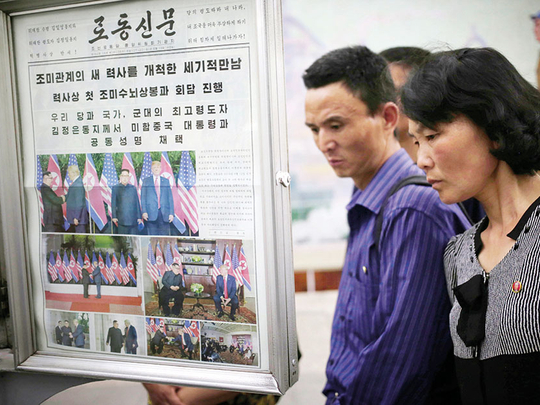
What’s the best-case and worst-case scenario we can hope for from the commitment between Donald Trump and Kim Jong Un? And how can anyone be sure that North Korea is really denuclearising? A look at some of the questions.
1. Between Trump and Kim, who got the better deal?
Both Trump and Kim got things they want. Trump appears to have resolved the immediate threat of war and cast himself as a peacemaker. But Kim’s wins — suspended US military drills, new international status, improved relations with China and South Korea and talk of easing sanctions — are more substantial.
2. What are the chances that the Koreas will actually be united as one nation?
They’re better now than they were a year ago. But reconciling the two political systems is daunting. More likely is decades of economic and cultural integration before anything that could be described as unification is possible.
3. How will this change relations between the US and South Korea, particularly the presence of US troops?
So far, Trump and South Korean President Moon Jae-in are pretty much in line. There are still few details about Trump’s decision to suspend US “war games” in South Korea, which could fuel discussion about a weakening of the alliance. While Trump has talked about lowering overseas troop deployments, he says that’s not on the table for South Korea right now.
4. What do we now know about Kim that we didn’t know before, based on his presence at the summit?
We know that Kim is far less cautious about his public appearances than many had surmised. He didn’t look exactly comfortable strolling around Singapore’s tourist spots surrounded by a phalanx of guards, but he spent more than two hours out on the town, and seemed happy to have those images published back in Pyongyang.
5. How can anyone be sure that North Korea is really denuclearising? And how can the US make sure Kim will keep his commitments?
That’s perhaps the biggest of the many questions left unanswered by this joint statement yesterday. Not only was there no mention of verification and inspection, but the two sides didn’t establish what denuclearisation means. Asked about this yesterday, Trump said: “I think he wants to get it done. I really feel that very strongly.”
6. Apart from denuclearisation, could you give a quick recap of what was agreed to at the summit and what we need to watch for in the coming months?
There are four main points of the joint statement: establishing new US-North Korea relations, building a lasting and stable peace regime, reaffirming North Korea’s commitment to “complete denuclearisation” and repatriating American war dead. There’s also Trump’s decision to suspend military exercises.
7. Did Trump or Kim say anything about the human rights record of North Korea? How will this rapprochement affect ordinary North Koreans?
This question led to some of the most interesting exchanges during Trump’s sprawling news conference after the signing with Kim. First, Trump acknowledged that human rights was not a major topic during the meeting, saying it “was discussed relatively briefly compared to denuclearisation.” When pressed later about whether he had betrayed the political prisoners in North Korean gulags, Trump suggested that improving relations would help them.
8. Who made this summit possible, and why wasn’t South Korean President Moon Jae-in invited?
A lot of people can claim credit for making the summit happen, Kim and Trump, obviously. But Moon played a key role in opening the dialogue and getting things back on track after Trump cancelled the meeting last month. China and Singapore also provided key logistical support.
9. Is this summit a game-changer for Asia and the rest of the world? Which countries have the most riding on a concrete peace deal?
Rather than a game-changer, this was more of a breakthrough in how the US and North Korea talk to each other. Having open channels of communication can only minimise the risk of miscalculation. North Korea and South Korea have the most riding on a peace deal, but China, which is next door, is probably next in line.
10. What have observers been saying about the possibility of Trump (or Kim) getting a Nobel Peace Prize?
Moon says Trump deserves a Peace Prize. Others might say it’s Moon who is probably more deserving, since he was pushing Trump and Kim toward peace when they were still both threatening nuclear war. Others might say let’s wait until there’s an actual peace deal before we start doling out accolades.
11. Why has it taken this long to get North Korea to the table? What’s the best-case and worst-case scenario we can hope for?
North Korea has resisted talks over the years because it disagreed with the US’s preconditions — mainly, a clear commitment to an inspection-and-verification regime. But it has long wanted a meeting with a US president. Trump’s decision to meet Kim without that clear path to denuclearisation removed the roadblock.
Best-case scenario is the two sides start talking, North Korea decides the US is no longer a threat and scales back its arsenal. Worst case is the US decides North Korea isn’t cooperating and we go back to war threats.
12. After all those nuclear and missile tests, it seems as if Kim Jong-un has suddenly signalled he wants peace. Why the change of strategy?
There is not enough known about North Korea to fully explain Kim’s motivations. But the North Koreans have expertly escalated and de-escalated tensions to suit their needs over the years. Now that Kim has a hydrogen bomb and missiles that can deliver it to the US, he says he doesn’t need to test them anymore and can dedicate more of his resources toward the economy.
Also, this has been a long time coming. Kim has put an increasing focus on developing his nation’s economy since he came to power in 2011.












